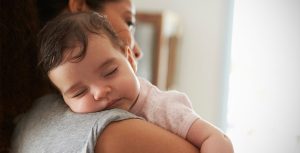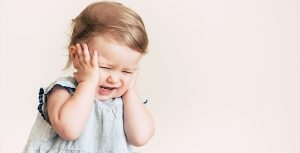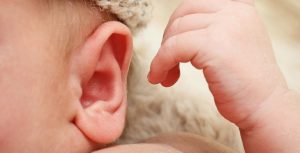
As a new parent, you want to do everything you can to ensure your baby is happy and healthy. You might be surprised to learn that one way to help your little one sleep soundly is by using white noise. Keep reading to learn more about the benefits of white noise for babies and how to use it effectively.
On AskHer, you will find relevant and reliable information regarding early childhood development from certified experts. Our goal is to empower women with the knowledge and support they need to make the best choices for themselves and their families.

First things first, let’s define what white noise is.
White noise is a consistent, low-frequency sound that can help mask other sounds. It can be produced naturally or artificially. Some examples of natural white noise include the sound of waves crashing on the beach or rain falling on a roof. Artificially created white noise might sound like a fan running or static on a television.
You’ve probably experienced white noise before without even realizing it. It’s the reason why you can sleep through the sound of a fan running in your room but wake up at the sound of a car horn outside.

Now that we know what white noise is, you might be wondering if it’s OK to use for babies. The answer is yes (under some precautions)! White noise can be a great way to soothe and calm your little one.
In fact, many hospitals use white noise machines to soothe premature infants in the NICU.
Think about it: when your baby is in the womb, they are constantly surrounded by the sound of your heartbeat and the whooshing of blood flowing through your body. Once they’re born, it can be difficult for them to adjust to the lack of this noise. White noise can help bridge that gap and make them feel more comfortable in their new environment.
In addition to providing comfort, white noise can also help your baby sleep. That’s because it can help block out other sounds that might wake them up, like a dog barking or a door slamming.
Baby And Toddler Sleep Expert, Katie Roeder, says:
So while there are certain things you need to be aware of when using white noise (like the volume and duration), it is generally considered safe and can be a helpful addition to your baby’s sleep routine.
—Some machines can produce hazardous noise levels. If you use a sleep machine, place it as far away from the baby’s head as possible and use it for a short time only.
Parents should also consult their child’s healthcare provider if they consider using white noise to help their baby sleep. Every child is different, and what works for one may not work for another. If you decide to use white noise, follow all manufacturer’s instructions carefully and never leave your baby unattended while the machine is on.
There are many benefits of using white noise to help your baby sleep, including the following:
In addition, white noise can help babies sleep through the night by drowning out any sudden noises that might wake them up. If your baby is easily startled by loud noises, white noise can provide a calming buffer to help them sleep more soundly.
Sudden Infant Death Syndrome, more commonly known as SIDS, is the leading cause of death for infants between one month and one year old. In the United States, there are about 3,400 cases of SIDS each year. While the exact cause of SIDS is unknown, several risk factors have been identified. One of these risk factors is exposure to loud noise.
While white noise won’t necessarily prevent SIDS, it can help reduce the risk of your baby being exposed to loud noises that might wake them up.f your baby is prone to startle at loud noises, white noise can provide a more tranquil environment to help them sleep better.
In addition, white noise can help children to sleep through longer periods of the night. This is important because research has shown that babies who sleep for more extended periods are at a reduced risk for SIDS.
One study found that white noise from a fan can help improve infant breathing patterns. This is important because one of the leading theories about what causes SIDS is that an infant’s breathing becomes irregular, and they are unable to wake up when they need oxygen.
More research needs to be done on the subject, but some evidence suggests that white noise can help reduce the risk of SIDS. If you are concerned about your infant’s risk of SIDS, you may want to consider using white noise in their sleep environment.

Now that you know the benefits of white noise for babies, you might wonder how to incorporate it into your little one’s sleep routine. Here are a few tips:
A white noise machine is specifically designed to produce calming sounds to help sleep peacefully.
When deciding on a white noise machine, check if the sound it produces is not too loud – surprisingly, many white noise machines promoted as perfect to use with babies do that (more on that later!).
You want a machine that will produce calming, relaxing sounds without being too jarring or overwhelming. Look for a machine that allows you to adjust the volume and tone so you can find the perfect sound for your baby. And make sure the device has an auto-off timer, so you don’t have to worry about it running all night long.
There are many white noise machines on the market, so take some time to find one that will work well for your family.
If you don’t want to invest in a machine, plenty of apps produce white noise sounds— and many of them are free!
Here are just a few of the many white noise apps available:
Just do a quick search on your app store of choice and browse the options until you find one you like.
If you’re in a pinch, you can also use household appliances to create white noise for your baby. For example, try running a fan or humidifier in your baby’s room while they sleep. Ensure the device is safe and won’t overheat the room during extended use.

Now that we know the benefits of white noise let’s talk about how to use it effectively. Here are a few things to keep in mind:

As our expert mentioned above:
—The safe decibel level for babies is around 50-60 dB which also depends on how close the sound machine is to your child as well as their age. Toddlers can handle slightly louder levels, with a max of 70 dB. I recommend keeping the sound machine across the room from your child or even near their bedroom door or window, depending on what noise you’re looking to block out.
In general, experts recommend keeping the volume at a level that is just barely audible to adults. For newborns and infants sleeping in the same room as the machine, this means setting the volume at a low setting. For older babies sleeping in a separate room, you might need to increase the volume slightly so they can still hear the sound over any ambient noises in their room (like a fan running or traffic outside).
The best way to test the volume of the white noise is to put it on at a low setting and then put your baby down for a nap. If your baby seems to be sleeping peacefully, you can leave it at that volume. But if your baby starts to fuss or cry, try turning it down a notch and see if that makes a difference. The volume is probably too loud if they seem agitated or disturbed by it. Observe your baby’s reaction to the noise and adjust the volume accordingly.
The jury is still out on whether or not white noise can cause hearing loss in babies. Some studies have shown that white noise can damage the hair cells in the inner ear, which can lead to hearing loss. However, other studies have shown that white noise does not damage these hair cells.
Interestingly, the AAP checked 14 white noise machines and found that all of them produced sound at too loud levels for infants. So if you are using a white noise machine for your baby, it’s essential to ensure that the volume is set at a safe level for their delicate ears.
Keep noise at a safe level for your baby. If white noise machines produce sound above safe decibel levels, and your baby is listening to it for an extended time, it can be harmful.
So, what does this mean for parents? If you are using white noise to help your baby sleep, it is crucial to monitor the volume closely. You should also take breaks from using white noise periodically so your baby’s ears can rest. If you have any concerns about your baby’s hearing or using white noise as a sleep aid, be sure to speak with your child’s pediatrician.

White noise can be an effective tool for calming a crying baby. It can be a helpful tool for babies who have trouble sleeping. White noise can help to block out any other noise in the environment and create a calming, soothing effect.
There are many different ways to create white noise, but it’s important to use it safely. When used correctly, white noise can help your baby get the restful sleep they need. It is important to use white noise responsibly and not rely on it too heavily.
Monitor the volume closely and take breaks from using it periodically. If you have any concerns about your baby’s hearing or using white noise as a sleep aid, be sure to speak with your child’s pediatrician.